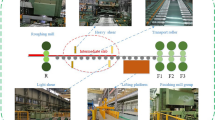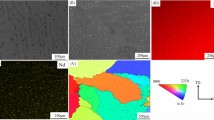Abstract
Due to the small range of plastic deformation temperatures during hot rolling of Zircaloy-4 plates, it is important to determine the appropriate flow behaviors for plate profile control of Zircaloy-4 plates. The developed microstructures and mechanical properties of Zircaloy-4 are evaluated by metallographic observations and Gleeble-3800 thermal simulation tester. To meet the need of data with small-sample properties, the support vector regression (SVR) algorithm is adopted to predict the constitutive model of Zircaloy-4, and the improved particle swarm optimization algorithm (IPSO) is used to optimize parameters of SVR algorithm. Meanwhile, results indicate that the correlation coefficient (R2) value of zirconium alloy constitutive model is 96.805%. Based on employed algorithm, comparing with modified Arrhenius model, the results show the superiority of IPSO-SVR algorithm. This provides an important theoretical basis for FE simulation of controlling the Zircaloy-4 plate shape during hot rolling process.









Similar content being viewed by others
References
I. Balasundar, T. Raghu, and B.P. Kashyap, Modeling the Hot Working Behavior of Near-α Titanium Alloy IMI 834, Prog. Nat. Sci. Mater. Int., 2013, 6, p 598–607. https://doi.org/10.1016/j.pnsc.2013.11.004
D.D. Chen, Y.C. Lin, and X.M. Chen, A Strategy to Control Microstructures of a Ni-Based Superalloy during Hot Forging Based on Particle Swarm Optimization Algorithm, Adv. Manuf., 2019, 7, p 238–247. https://doi.org/10.1007/s40436-019-00259-0
D.G. He, Y.C. Lin, J. Chen, D.D. Chen, J. Huang, Y. Tang, and M.S. Chen, Microstructural Evolution and Support Vector Regression Model for an Aged Ni-Based Superalloy during Two-Stage Hot Forming with Stepped Strain Rates, Mater. Des., 2018, 154, p 51–62. https://doi.org/10.1016/j.matdes.2018.05.022
G.L. Jia, F.G. Li, Q.H. Li, H.Q. Li, and Z. Li, Prediction of the Hot Deformation Behavior for Aermet100 Steel using an Artificial Neural Network, Comput. Mater. Sci., 2010, 48(3), p 626–632. https://doi.org/10.1016/j.commatsci.2010.02.031
J.G. Cao, T.C. Wang, H.B. Li, Y. Qiao, D. Wen, and Y.S. Zhou, High-Temperature Deformation Constitutive Relationship of Non-Oriented Electrical Steel Based on Arrhenius Improved Model, Chin. J. Mech. Eng., 2016, 52(4), p 90–96. https://doi.org/10.3901/JME.2016.04.090
W.G. Wang and B.X. Zhou, The Effect of Rolling Temperature on the Texture of Zr-4 Alloy Plate, Nucl. Power Eng., 1996, 3, p 255–261.
Q. Peng, W.J. Zhao, Y.Z. Liu, and C.L. Sun, Texture Evolution of Zr-4 Alloy Sheet Rolling in α Phase High Temperature Zone, Nucl. Power Eng., 2003, 2, p 33–136. https://doi.org/10.3969/j.issn.0258-0926.2003.02.008
J.K. Chakravartty, G.K. Dey, and S. Banerjee, Dynamic Recrystallisation During Hot Working of Zr-2.5Nb Characterisation using Processing Maps, Metal. Sci. Tech., 1996, 12(9), p 705–716. https://doi.org/10.1179/mst.1996.12.9.705
J.K. Chakravartty, S. Banerjee, Y.V.R.K. Prasad, and M.K. Asundi, Hot-Working Characteristics of Zircaloy-2 in the Temperature Range of 650–950°C, J. Nucl. Mater., 1992, 187(3), p 260–271. https://doi.org/10.1016/0022-3115(92)90506-G
J.J. Liu, K.L. Wang, X.Y. Gao, X. Li, and F. Zhou, Hot Deformation Behavior and Processing Map of Zr-4 Alloy, J. Nucl. Mater., 2020, 531, 151993. https://doi.org/10.1016/j.jnucmat.2020.151993
X.Y. Gao, in Research on Hot Deformation Behavior of Zr-4 Alloy and Optimization of Process Parameters (2018). CNKI: CDMD:2.1018.816881
B.H. Jia, W.D. Song, H.P. Tang, Z.H. Wang, X.N. Mao, and J.G. Ning, Hot Deformation Behavior and Constitutive Model of TC18 Alloy During Compression, Rare Met., 2014, 33(004), p 383–389. https://doi.org/10.1007/s12598-014-0328-x
L. Zhang, Q. Wang, Y.B. Yang, and C. Cheng, Thermal Deformation Strain Compensation Constitutive Model of Cast Rare Earth Magnesium Alloy, Hot WorK. Tech., 2015, 16, p 131–134. https://doi.org/10.14158/j.cnki.1001-3814.2015.16.037
M. Bagheripoor and H. Bisadi, Application of Artificial Neural Networks for the Prediction of Roll Force and Roll Torque in Hot Strip Rolling Process, Appl. Math. Model., 2013, 37(7), p 4593–4607. https://doi.org/10.1016/j.apm.2012.09.070
Z. Sun, X. Wang, and J. Zhang, Prediction and Control of Equiaxed α in Near-β Forging of TA15 Ti-Alloy Based on BP Neural Network: for Purpose of Tri-Modal Microstructure, Mater. Sci. Eng., 2014, 591, p 18–25. https://doi.org/10.1016/j.msea.2013.10.080
R. Kapoor, D. Pal, and J.K. Chakravartty, Use of Artificial Neural Networks to Predict the Deformation Behavior of Zr-2.5 Nb-0.5 Cu, J Mater. Process. Technol., 2005, 169(2), p 199–205. https://doi.org/10.1016/j.jmatprotec.2005.03.022
A. Abdiansah and R. Wardoyo, Time Complexity Analysis of Support Vector Machines (SVM) in LibSVM, Int. J. Comput. Appl., 2015, 128(3), p 975–8887. https://doi.org/10.5120/ijca2015906480
C. Chen, G.H. Zhang, Z. Qian, R.A. Tarefder, and Z. Tian, Investigating Driver Injury Severity Patterns in Rollover Crashes using Support Vector Machine Models, Accid. Anal. Prev., 2016, 90, p 128–139. https://doi.org/10.1016/j.aap.2016.02.011
M. Goudjil, M. Koudil, M. Bedda, and N. Ghoggali, A Novel Active Learning Method using SVM for Text Classification, Int. J. Autom. Comput., 2018, 15(3), p 290–298. https://doi.org/10.1007/s11633-015-0912-z
S. Zhang, W.L. Jiang, and J.H. Zhang, Research on Precise Setting Method of Rolling Force of Cold Tandem Mill Based on Support Vector Machine Prediction, Hydraul. Pneum., 2017, 07, p 50–55. https://doi.org/10.11832/j.issn.1000-4858.2017.07.009
Z.M. Chen, F. Luo, and X.H. Huang, Rolling Force Prediction Based on Chaos Optimization Support Vector Machine, Control Decis., 2009, 24(006), p 808–812. https://doi.org/10.3321/j.issn:1001-0920.2009.06.002
J.Y. Zhang, Y.P. Liao, S.F. Wang, and J. Han, Study on Driving Decision-Making Mechanism of Autonomous Vehicle Based on an Optimized Support Vector Machine Regression, Appl. Sci., 2017, 8(1), p 13. https://doi.org/10.3390/app8010013
N. Guenther and M. Schonlau, Support Vector Machines, Stata J.: Promot. Commun. Stat. Stata., 2016, 16(4), p 917–937. https://doi.org/10.1177/1536867X1601600407
A.L. Chen, Deformation Resistance Prediction Model and Its Application Research, Comput. Integr. Manuf. Syst., 2007, 13(9), p 1816–1819. https://doi.org/10.1109/CISE.2009.5363118
G.P. Zhang, W.J. Wang, J. Du, H. Liu, and P. Varilone, A Multi-objective Optimal Operation of a Stand-Alone Microgrid using SAPSO Algorithm, J. Electr. Comput. Eng., 2020, 19, p 1–16. https://doi.org/10.1155/2020/6042105
P. Liu, M.C. Xie, J. Bian, H.S. Li, and L.L. Song, A Hybrid PSO–SVM Model Based on Safety Risk Prediction for the Design Process in Metro Station Construction, Int. J. Environ. Res. Public Health, 2020, 17(5), p 1714. https://doi.org/10.3390/ijerph17051714
S. Sarkar, S. Vinay, R. Raj, J. Maiti, and P. Mitra, Application of Optimized Machine Learning Techniques for Prediction of Occupational Accidents, Comput. Oper. Res., 2019, 106, p 210–224. https://doi.org/10.1016/j.cor.2018.02.021
A. Ratnaweera, S.K. Halgamuge, and H.C. Watson, Self-Organizing Hierarchical Particle Swarm Optimizer with Time-Varying Acceleration Coefficients, IEEE Trans. Evol. Comput., 2004, 8(3), p 240–255. https://doi.org/10.1109/TEVC.2004.826071
P.Q. Huang, J.C. Liu, and S.B. Tan, Application of Hybrid Multi-objective Particle Swarm Optimization Algorithm in Load Distribution Optimization of Hot Finishing Rolling, Control Theory Appl., 2017, 34(1), p 93–100. https://doi.org/10.7641/CTA.2017.60299
Z.H. Wang, Y.M. Liu, and D.Y. Gong, A New Predictive Model for Strip Crown in Hot Rolling by Using the Hybrid AMPSO-SVR-Based Approach, Steel Res. Int., 2018, 89(7), p 180003. https://doi.org/10.1002/srin.201800003
L.Y. Wang, L. Li, and Z.H. Zhang, Accurate Descriptions Of Hot Flow Behaviors Across β Transus of Ti-6Al-4V Alloy by Intelligence Algorithm GA-SVR, J. Mater. Eng. Perform., 2016, 25(9), p 1–12. https://doi.org/10.1007/s11665-016-2230-1
M. SeyedSalehi and S. Serajzadeh, A Model to Predict Recrystallization Kinetics in Hot Strip Rolling using Combined Artificial Neural Network and Finite Elements, J. Mater. Eng. Perform., 2009, 18, p 1209–1217. https://doi.org/10.1007/s11665-009-9359-0
P. Pourabdollah and S. Serajzadeh, A Study On Deformation Behavior of 304l Stainless Steel During and After Plate Rolling at Elevated Temperatures, J. Mater. Eng. Perform., 2017, 26, p 885–893. https://doi.org/10.1007/s11665-016-2475-8
J. Ni, L. Wang, and Z.H. Zhang, Research on the Interface Heat Transfer Behavior of Zr-4 Alloy and H13 Die Steel, Rare Met. Mater. Eng., 2019, 48(05), p 1579–1583.
Y.L. Li, J.G. Cao, L. Qiu, L. Kong, and Y.Z. Zhou, Effect of Strip Edge Temperature Drop of Electrical Steel on Profile and Flatness during Hot Rolling Process, Adv. Mech. Eng., 2019, 11(4), p 168781401984047. https://doi.org/10.1177/1687814019840471
J.G. Cao, X.T. Chai, Y.L. Li, N. Kong, S.H. Jia, and W. Zeng, Integrated Design of Roll Contours for Strip Edge Drop and Crown Control in Tandem Cold Rolling Mills, J. Mater. Process. Technol., 2018, 252(2), p 432–439. https://doi.org/10.1016/j.jmatprotec.2017.09.038
X.C. Guo, B.F. Luan, and J.W. Chen, Research on the Precipitation Phase Distribution Characteristics of N18 Zirconium Alloy, Rare Met. Mater. Eng., 2011, 40(05), p 813–816.
K.K. Saxena, S.D. Yadav, and S. Sonkar, Effect of Temperature and Strain Rate on Deformation Behavior of Zirconium Alloy: Zr-2.5Nb-0.5Cu, Procedia Mater. Sci., 2014, 6, p 188–193. https://doi.org/10.1016/j.mspro.2014.07.035
R.N. Wang, Z.P. Xi, Y.Q. Zhao, and Y.L. Qi, Analysis of the Hot Deformation Structure and Mechanism of Zr-4 Alloy, Heat Treat. Met., 2007, 32(6), p 15–18. https://doi.org/10.3969/j.issn.0254-6051.2007.06.004
A. Cevik, A.E. Kurtoğlu, M. Bilgehan, M.E. Gülşan, and H.M. Albegmprli, Support Vector Machines in Structural Engineering: A Review, J. Civ. Eng. Manag., 2015, 21(3), p 261–281. https://doi.org/10.3846/13923730.2015.1005021
C.S. Jiang and G.Q. Liang, Modeling Shear Strength of Medium- to Ultra-High-Strength Concrete Beams with Stirrups using SVR and genetic algorithm, Soft. Comput., 2021, 25(16), p 10661–10675. https://doi.org/10.1007/s00500-021-06027-2
Acknowledgment
This work was supported by the National Science and Technology Major Project of China (2019ZX06002001-004), the Scientific and Technological Innovation Foundation of Shunde Graduate School of University of Science and Technology Beijing (BK19A006) and the Innovation Method Fund of China (2016IM010300).
Author information
Authors and Affiliations
Corresponding author
Additional information
Publisher's Note
Springer Nature remains neutral with regard to jurisdictional claims in published maps and institutional affiliations.
Rights and permissions
About this article
Cite this article
Cao, Y., Cao, J., Wang, L. et al. High-Temperature Deformation Constitutive Model of Zircaloy-4 Based on the Support Vector Regression Algorithm during Hot Rolling. J. of Materi Eng and Perform 31, 10237–10247 (2022). https://doi.org/10.1007/s11665-022-06987-y
Received:
Revised:
Accepted:
Published:
Issue Date:
DOI: https://doi.org/10.1007/s11665-022-06987-y




